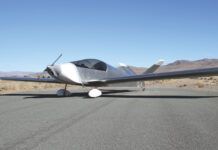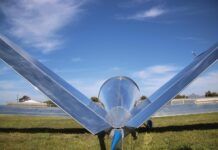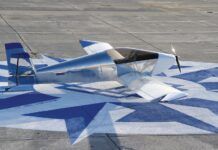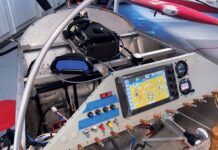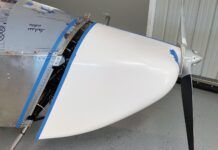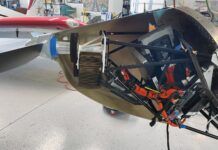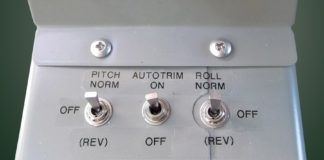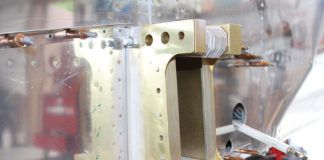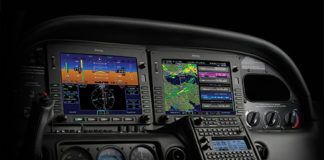Kitplanes own Dean Sigler (Alternative Energies) attended this year’s Electric Aircraft Symposium in Santa Rosa, CA (April 25-26th) as part of the faculty for the event, and filed this second of three reports in order to keep our readers up to date on the burgeoning new technologies in electrical propulsion and aircraft designed to use it. Watch for additional reports here and in the magazine as we keep abreast of the action in the world of “green flight”.
Paul Dye, EIC
The CAFE Foundation’s Electric Aircraft Symposium has grown from its original half day with 20 or so attendees to the 200-person knowledge fest we see today.
After a rousing series of announcements from Foundation Vice President Larry Ford, JoeBen Bevirt and Mark Beirele shared their options for flight with Joby motors.
The audience saw a video of Beirele’s e-Gull, powered with a Joby motor, as it lifted off from Mark’s hill-top runway and climbed briskly. Mark reported that his Earthstar aircraft reached 9,000 feet at full throttle on its 20 kilowatt motor without overheating. He’s put 130 hours on the motor as of the Symposium. The direct drive Joby motor uses a Zero motorcycle battery and a Kelly controller.
www.jobyaviation.com/S2
www.thundergull.com
www.jobyaviation.com/lotus
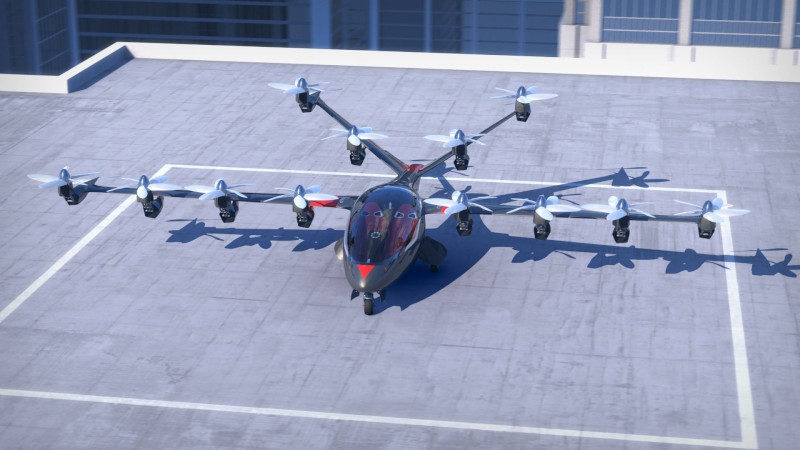
JoeBen had something more complex to share, a 12-rotor, tilting motors and folding propellers craft that could save its two passengers a big part of their 1.6 hour commute time each day. With 250 Watt-hour per kilogram batteries now available, JoeBen suggested that it’s time to make some magic. He thinks we can take those passengers 200 miles at 200 mph for $20 in operating costs. That would be cheap travel free of TSA inspections and the long trip to the airport.
His Lotus is a long endurance UAV inspired by Mark Moore’s Samara, with wingtips that fold out to become rotors, pulling the airplane skyward. A tail rotor can either face up to balance the airplane in vertical takeoff mode or during hovering, or tilt forward to help drive the UAV forward. This 75-pound vehicle could carry significant payloads. Finally, the LeapTech could carry four people at 300 mph, and its high-lift wings could get them in and out of small airports.
They’re probably not hipsters, but Dr. Tine Tomazic and Dr. Gregor Veble introduced their HypstAir (HYbrid Propulsion SysTem for AIRcraft), a design approach for the Pipistel Panthera destined to be a certified hybrid aircraft. It will feature an advanced human-machine interface to fully utilize the benefits of this high-performance machine in safety. Batteries and electrical components are already integrated into the airframe, and the business end looks formidable with its five-bladed propeller and cowling with three cooling intakes. Its battery management system will tend the battery pack with active balancing.
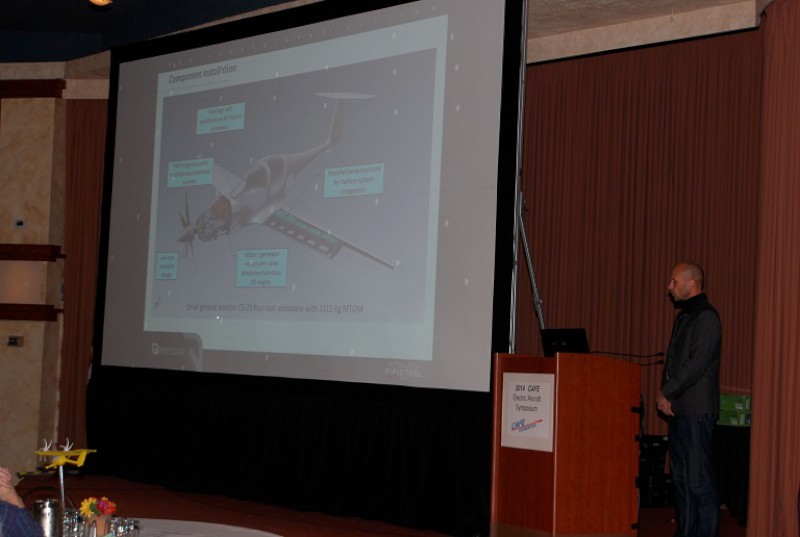
Tine heads the ASTM group developing standards for pilot interfaces in the new craft, noting that “nobody likes to contribute to standards – but likes it when they’re done.” As the Pipistrel team crafts the many systems for this machine, Gregor explained that, “Development goes at the speed of cash.”
In an entertaining and enlightening talk, Aaron Singer, owner of Seaplane Adventures in San Francisco, used his experience flying tours around the Bay Area in DeHavilland Beavers and Cessna 172s on floats to explain why electric seaplanes are a difficult proposition. Hydrodynamic drag, the friction of floats or hull against the water, means it takes large amounts of power to get over the “hump,” that point where thrust finally overcomes water resistance and the seaplane gets on “the step” and can lift off. That large power input means an electric seaplane uses a great amount of power to merely take off, leaving lesser amounts of stored energy for cruising around. He noted that all the electric seaplanes so far have been ultralights for that reason.
Brian Carpenter, CEO of Rainbow Aviation Services, shared his drive to develop an FAR Part 103 compliant electric ultralight glider. He strives toward a design that would combine ease of flying with good performance, folding wings to reduce or eliminate hangar rent, simplified construction and low cost. His EMG-6 could use modular power units, so that a builder could choose one small sustainer motor, a single larger motor for self-launching, or two or even three motors for two-place instruction in the airplane. In a type of hybrid configuration, one or more motors could be electric or internal combustion for different missions. Brian’s videos of flying with his hands and feet off the controls showed the stability of the basic design.
electricmotorglider.com/index.html
See a version of his CAFE talk on YouTube: www.youtube.com/watch?v=9Y2fYDgJGhc&feature=youtu.be
Roman Susnik, creator of are claimed to be the most powerful electric motors for their weight, could not attend, but Tine Tomazic showed videos of land, sea and air applications of Susnix EMRAX motors. They are flying on the Apis, Taurus Electro G2, the Binder EB-29, and the Eurosport Crossover motorgliders and powering Ohio State’s CURRENT electric motorcycle, slated to race at the Isle of Man TT. A video of a sleek little mahogany speed boat powered by a liquid-cooled EMRAX was particularly exciting.
www.enstroj.si/News/nessmann-electric-boat-with-emrax-228.html
Avetik Haryutunyan, Chief Scientist at Honda Motors’ Materials Science Division in Columbus, Ohio, was on hand to review his experimental work on creating high lithium storage in carbon nanostructures. He traced electrical energy storage back to the Baghdad Battery of pre-common-era times, and showed a series of stages that have brought us to today’s best commercial batteries. His work has taken him onto some interesting avenues of research, but beyond graphene, carbon nanotubes, and he’s looking at producing defects in carbon materials that increase energy capacity, and comparing other materials such as boron and silicon for their potential in battery development. That Honda is involved shows the plausible commercial realizations that could come from such research.
www.honda-ri.com/HRI_Us/material-science.php
Tian Yu, founder and head of Yuneec Electric Aircraft, kicked off his talk with a demonstration of his company’s quadrotor, followed up with allowing a brave attendee to try out Yuneec’s 20-mile range electric skateboard (which the attendee handled with applause-worthy skill), and filled us in on developments with the Greenwings Spyder, an ultralight that flew the first two-plane electric formation at last year’s AirVenture, and the e430, which has its motor sitting five inches higher than the original design, and the landing gear sitting a little lower. This airplane should be entering the American market in the near future – or at least when rules permit.
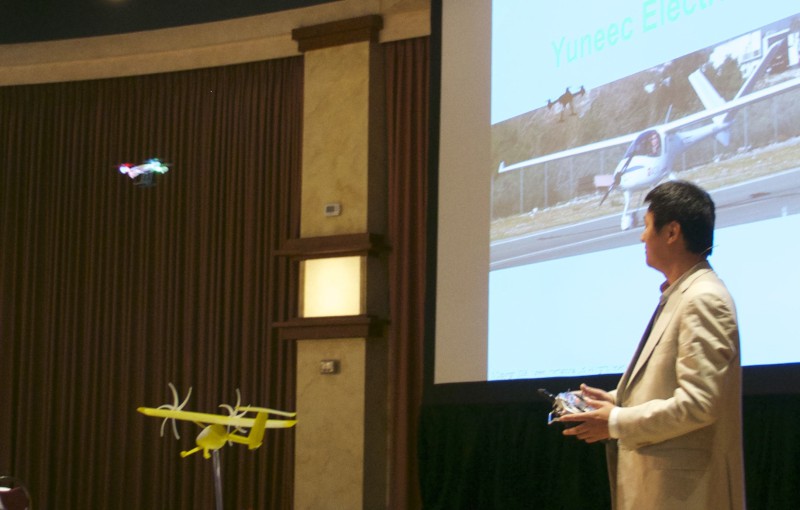
Anton Dilcher of Idaflieg, a consortium of German akafliegs – academic flying clubs – closed out the morning. He showed and discussed the impressive range of aircraft designed, built, and test flown over the last 70 years by students. Their efforts have included variable geometry aircraft, extendable wings, attempts to reduce interference drag, and powered gliders such as use of electric sustainer motors, jet turbines, and even diesel engines. Their work is well worth researching because so much of it follows the ideas promoted by the CAFE Foundation.
This year’s Symposium left people well pleased with the depth and breadth of information they received, and helped make connections that may prove invaluable in the further development of this new aviation technology. Evidence overheard by this correspondent suggests that homebuilders may see kits, motors, and accessories coming that will make it possible to build and fly one’s own electric dream – sooner rather than later.


